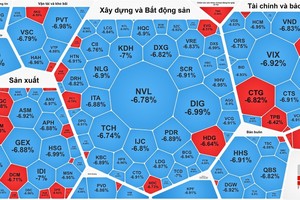With an unstable export market this year, the larger garment and textile companies are heaving a sigh of relief as most of their workers returned back to work after a lengthy Tet holiday, while the smaller units are still waiting for many to return so as to complete a backlog of orders.
Labour crunch hits small businesses

Phung Dinh Ngo, director of the Binh Hoa Garment Company, employing around 100 workers, said that only 60 per cent of his workers had returned from their vacation which started from January 18 to February 1.
This problem plagues most of the smaller garment and textile companies each year as most of them lack the facilities to work directly with importers and foreign buyers and many only handle outsourcing jobs for bigger companies.
Because of a limited salary structure, small units find it difficult to retain workers for a longer period of time. Hence, the small companies are always faced with a shortage of labour, Ngo sighed.
However, unlike previous years, most of the workers returned to work soon after the Tet holidays, which was encouraging for the big garment companies. One of the reasons which raised workers loyalties to the big companies was higher salary and more benefits. Not only did they receive higher bonus, but some firms also hired buses to take workers to their hometown for Tet and bring them back to work after the holidays. They also offered a longer holiday and rewarded workers who came back to work on time with an extra VND500,000 bonus each, which boosted sentiment.
Previously, scores of workers were known to quit their jobs in big companies during the first week after Tet. Nonetheless, big companies re-recruited enough people to make up for the shortfall in a matter of days.
Concerns over shortage of orders
Vietnam Textile and Apparel Association (Vitas) has predicted a rough year for the country’s garment industry, with exports only rising by 10-12 per cent over last year to US$15 billion this year. The industry recently saw a drop in orders from European importers, the country’s second largest market, due to the eurozone debt crisis, though the US, Japan and some other markets have remained optimistic.
Many companies have chosen to reduce orders from EU countries and increase exports to the US, Japan, countries in the ASEAN, Korea and Russia.
Saigon Garment Manufacturing Trading Company which previously specialised in exports to EU countries has adjusted its production plan for this year. It has cut products for the EU market to 40 per cent from a previous 70 per cent and raised that for the US market to 40 per cent from 20 per cent, and for Japan to 15 per cent.
Meanwhile, with 50 per cent export to Japan, and 30 per cent to the US, Saigon 3 Garment Joint Stock Company is concerned that it would fail to complete orders by February this year as orders from Japan are huge.
Currently, random orders are rare as most importers have lowered production orders on a long term basis, as they had done before. Garment companies are nervous as the numbers of orders have not been stable and not enough to ensure their operations for the year. At this moment, garment enterprises and importers are waiting for new developments in the market.
According to Vitas, garment exports to the US reached $7.1 billion in 2011, up 13 per cent over the previous year, to the EU market they touched $2.4 billion, increased by 25 per cent compared to 2010, and to Japan they reached $1.65 billion to gain by 43 per cent.
Figures show that although the EU market cooled down, the US market has gradually warmed up. Generally, the situation for the garment industry is still not desperate.
Although garment export turnover declined in January this year, reaching $950 million is still very encouraging. Even small businesses like Binh Hoa Garment Company received orders for April and May.
Le Dong Trieu, general director of the Gia Dinh Textile and Garment Corporation, said that his company had drawn some solutions for its operations this year. Accordingly, the company will continue to work with its traditional customers, but in addition, it will also expand and seek for new partners in other markets.
























